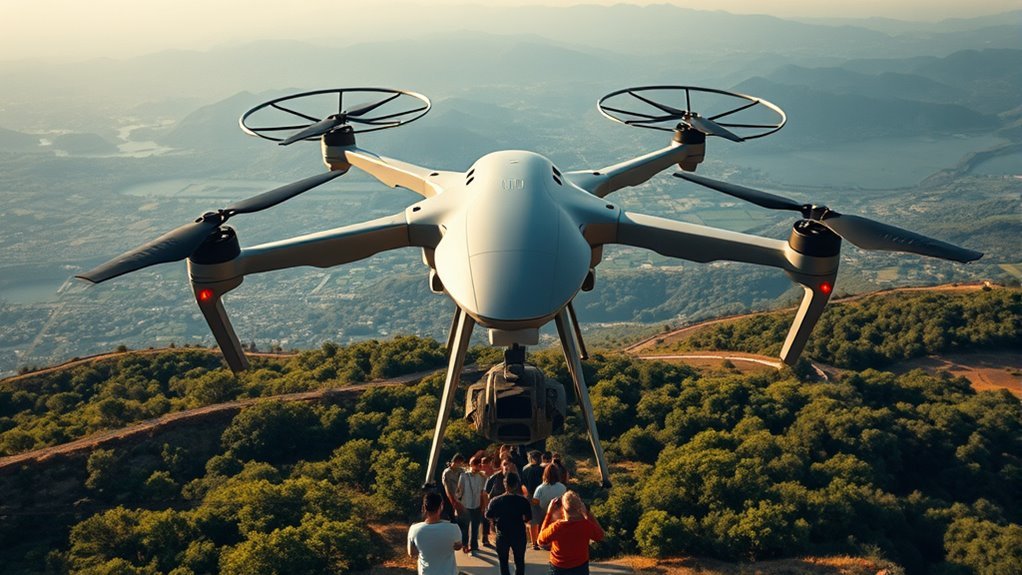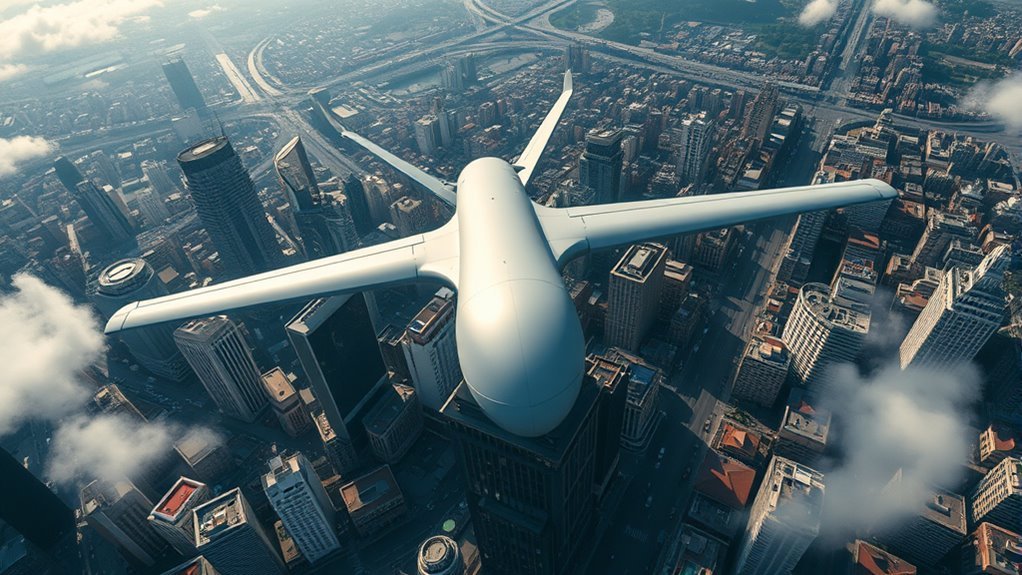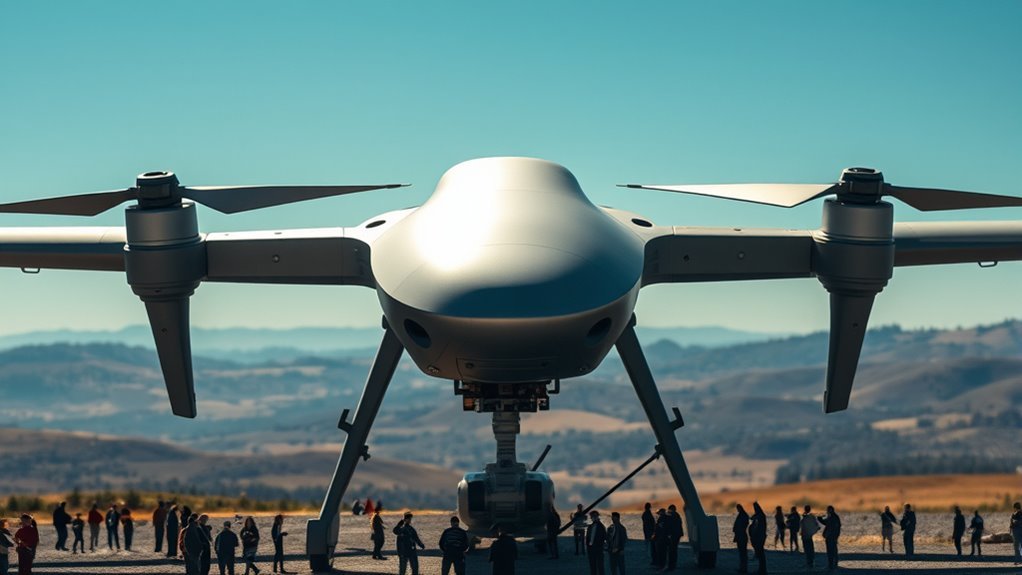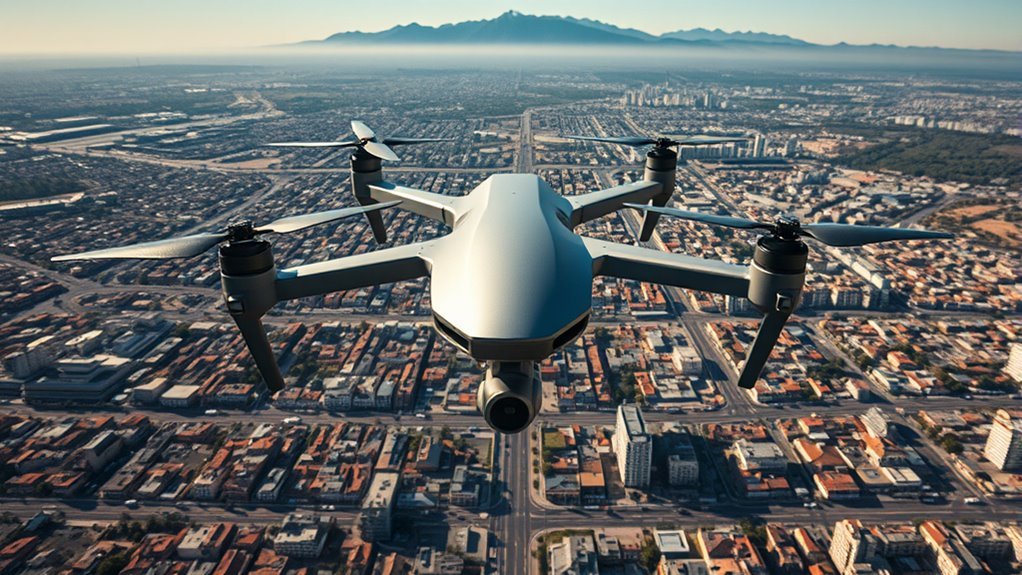Drones can vary in size from micro to large, with some of the largest, like the Northrop Grumman Global Hawk, boasting a wingspan of 130 feet. Size affects payload capacity, flight time, and operational range. Regulatory limitations greatly influence design and usability, particularly for larger drones. Innovations in materials and technology are driving size expansion, allowing for enhanced capabilities. As you explore further, you’ll discover the evolving landscape of drone applications and future trends.
Understanding Drone Size Categories

While you might think of drones as a single category, they’re actually divided into several size classifications, each serving distinct purposes and functionalities. Understanding these drone types is essential for any enthusiast seeking to explore their capabilities. Size standards typically categorize drones as micro, mini, small, medium, and large. Micro drones, often used for indoor flights, are lightweight and compact, while large drones can carry substantial payloads for commercial applications, such as professional-grade cameras like those supported by the Freefly Alta 8 Pro. Each size class influences flight time, range, and payload capacity, making it important for users to choose the right type based on their intended use. By grasping these classifications, you can better appreciate how drone dimensions affect performance and functionality in diverse environments. Additionally, payload capacity varies significantly across different drone sizes, impacting their application in fields such as logistics and emergency response.
Factors Influencing Drone Dimensions

When considering drone dimensions, regulatory limitations and design considerations play essential roles. You need to be aware of the weight and size restrictions imposed by aviation authorities, which can greatly impact your design choices. Additionally, the intended application of the drone will dictate specific design requirements that further influence its overall size. Understanding federal aviation regulations can help ensure compliance while designing larger drones for various uses. For instance, drones used for commercial applications must adhere to stricter registration requirements based on their size and capabilities.
Regulatory Limitations
As the demand for drones grows, regulatory limitations considerably shape their dimensions and capabilities. You must navigate various regulatory frameworks that dictate size, weight, and operational altitude. These regulations are primarily designed for effective airspace management, ensuring safety and minimizing risks of mid-air collisions. For instance, drones exceeding certain weight thresholds may require special permits or certifications, restricting their usability for commercial applications. Additionally, specific airspace restrictions can limit where larger drones can be flown, further influencing their design. Understanding these limitations is essential if you aim to maximize drone potential while remaining compliant. Ultimately, regulatory constraints can both empower and hinder innovation, making it vital for you to stay informed and adaptable in this dynamic environment.
Design Considerations
Despite regulatory constraints, several design considerations greatly influence drone dimensions. One primary factor is aerodynamic efficiency; larger drones can achieve better lift and stability, but they also face increased drag. You’ll need to balance size with aerodynamics to enhance performance. Additionally, weight distribution plays a vital role; uneven weight can compromise flight stability and control. When designing your drone, consider the placement of components—such as batteries and payloads—to maintain an ideal center of gravity. The choice between fixed-wing and multi-rotor designs also affects dimensions, as each has unique advantages and limitations. Ultimately, understanding these factors helps you push the boundaries of size while ensuring functional efficiency and adherence to safety standards.
Current Largest Drones in Operation

Currently, several drones have reached impressive sizes, pushing the boundaries of aerial technology. The largest operational drones, such as the Northrop Grumman Global Hawk, showcase capabilities essential for military applications, including reconnaissance and surveillance. These drones can span over 130 feet in wingspan, allowing them to cover vast areas and gather critical intelligence. The design of these drones often incorporates high-quality materials that ensure durability and performance in various conditions.
In the industrial sector, the Airbus Zephyr is another significant example, designed for high-altitude long-endurance missions. Its solar-powered design enables extended operational periods, making it ideal for telecommunications and environmental monitoring. As you explore the current largest drones, you’ll see how their size not only enhances functionality but also opens new avenues for freedom in both military and industrial uses. The incorporation of advanced camera capabilities in these large drones allows for high-quality visual content, making them even more valuable for various applications.
Potential Applications for Larger Drones
Larger drones present significant opportunities in various sectors, particularly in cargo transportation, emergency response, and agricultural monitoring. Their increased payload capacity can streamline logistics, enhance disaster relief efforts, and improve crop management through precise data collection. As you explore these applications, consider how advancements in drone technology can transform these industries. For instance, drones can utilize precision planting techniques to optimize seed placement and increase agricultural productivity. Additionally, the integration of real-time data analysis from Delair’s cameras can further enhance decision-making in crop management.
Cargo Transportation Solutions
As the demand for efficient logistics solutions continues to rise, the potential applications for larger drones in cargo transportation are becoming increasingly relevant. These drones can greatly enhance transport efficiency while boosting cargo capacity. By utilizing larger models, companies can streamline operations and reduce costs.
| Feature | Larger Drones | Traditional Methods |
|---|---|---|
| Cargo Capacity | Up to 500 lbs | Typically 150 lbs |
| Transport Efficiency | 60% faster delivery | Standard delivery times |
| Operational Range | 200 miles | Limited to 50 miles |
Incorporating larger drones can revolutionize supply chains, enabling quicker response times and broader service areas. Ultimately, embracing these innovations could open up unprecedented freedom in logistics.
Emergency Response Operations
When emergencies arise, the ability to deploy larger drones can greatly enhance response operations. These drones can transport essential supplies, medical equipment, and personnel to inaccessible areas, considerably improving emergency logistics. By employing advanced drone deployment strategies, agencies can optimize resource allocation during crises. Larger drones can cover vast distances quickly, providing real-time situational awareness and aiding in damage assessment. They can also assist in search and rescue missions, locating survivors in challenging environments. With their capacity to carry heavier payloads, larger drones can deliver critical aid faster than traditional methods, ensuring that help reaches those in dire need. Ultimately, integrating these drones into emergency response frameworks empowers communities to respond more effectively and efficiently in times of crisis.
Agricultural Monitoring Capabilities
The integration of larger drones into agricultural monitoring presents significant advancements in precision farming practices. These drones can cover expansive areas, providing detailed insights into crop health that smaller models simply can’t achieve. By employing advanced sensors and imaging technologies, larger drones enable farmers to make data-driven decisions that enhance yield and resource efficiency.
| Feature | Benefits |
|---|---|
| High-resolution imaging | Improved crop health assessment |
| Extended flight time | Increased area coverage |
| Advanced sensors | Enhanced data accuracy |
With these capabilities, you can monitor your fields more effectively, identify issues early, and optimize your farming strategies. Ultimately, larger drones are revolutionizing precision agriculture, granting you unprecedented freedom to manage resources efficiently.
Technological Innovations Driving Size Expansion
While many might assume size limitations constrain drone development, technological innovations are continually pushing these boundaries. Advances in materials and design are enabling manufacturers to achieve significant size optimization and weight reduction, allowing for larger drones with enhanced capabilities. Here are some key innovations driving this growth:
- Lightweight composites: Reducing overall weight while maintaining structural integrity.
- Advanced battery technologies: Offering longer flight times and less weight, which is crucial for enhanced autonomy during extended missions.
- Efficient propulsion systems: Maximizing lift and minimizing energy consumption.
- Modular designs: Allowing for easy upgrades and customization, thereby expanding functional capabilities.
- AI-driven navigation: Enhancing operational efficiency and enabling larger-scale missions.
Moreover, the integration of advanced technologies into drone systems is essential for improving user engagement and operational versatility.
These developments provide the freedom to explore new applications, ultimately expanding the potential of drone technology.
Regulatory Challenges for Giant Drones
As drone technology evolves and sizes increase, maneuvering the regulatory landscape becomes increasingly complex. Giant drone regulations are struggling to keep pace with advancements, leading to potential safety concerns. You must understand the implications of these regulations for your operations. Additionally, the integration of collision avoidance technology is crucial for ensuring the safety of giant drones in shared airspace. Maintaining visual line of sight is essential for safe navigation and compliance with regulatory standards.
| Regulatory Aspect | Description |
|---|---|
| Registration | Mandatory for all giant drones |
| Airspace Management | Coordination with existing traffic |
| Safety Standards | Compliance with established norms |
| Operational Limits | Restrictions on weight and altitude |
| Privacy Concerns | Addressing public space issues |
Navigating this framework is essential for ensuring both compliance and operational freedom. Balancing innovation with safety standards is key to revealing the potential of giant drones in various sectors.
Future Trends in Drone Development
Regulatory challenges are only one aspect of the rapidly evolving drone landscape; advancements in technology are driving significant changes in drone design and functionality. As you explore the future of drone development, keep an eye on these trends:
- Enhanced autonomous navigation systems for improved safety and efficiency.
- Increased heavy lift capabilities allowing for transport of larger payloads.
- Integration of AI for smarter decision-making in flight operations.
- Development of hybrid drones combining electric and fuel power for extended range.
- Expansion into new sectors like agriculture, delivery, and emergency services. Future models will also feature advanced AI integration that enhances autonomous decision-making and mission adaptability.
These innovations will not only push the boundaries of what drones can achieve but also empower you to utilize them in ways previously thought impossible, fostering a sense of freedom in aerial operations. Additionally, advancements in AI-driven autonomy are set to revolutionize how drones operate in complex environments, enhancing their effectiveness and adaptability.
Frequently Asked Questions
What Are the Smallest Drones Currently Available on the Market?
You’ll find the smallest drones available, like micro drone technology and mini quadcopters, offering compact designs for versatility. These tiny devices excel in agility and portability, catering to enthusiasts seeking freedom in aerial exploration.
Can Drones Be Designed for Underwater Navigation?
Imagine exploring ocean depths like a modern-day Jacques Cousteau. Underwater drones equipped with advanced navigation technology are designed for such adventures, allowing you to traverse uncharted waters, capturing insights previously reserved for only the most daring explorers.
How Do Weather Conditions Affect Drone Size Capabilities?
Weather conditions greatly impact a drone’s size capabilities. Larger drones may struggle with flight stability in high winds, while weather resistance becomes essential. You’ll want to take these factors into account when designing for ideal performance and safety.
Are There Specific Materials Used for Building Larger Drones?
When considering materials for larger drones, you’ll find advanced composites essential for maintaining structural integrity. These lightweight yet strong materials allow for increased size without compromising performance, giving you the freedom to innovate without limitations.
What Are Common Misconceptions About Drone Size Limitations?
You might think drone weight only depends on size, but regulations often impose limits. Many overlook how design, materials, and purpose also dictate drone size, limiting potential for innovation in larger, more capable drones.

